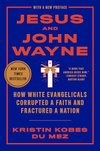Jesus and John Wayne: How White Evangelicals Corrupted a Faith and Fractured a Nation
amazon.com
Saved by Lael Johnson and
Jesus and John Wayne: How White Evangelicals Corrupted a Faith and Fractured a Nation

Saved by Lael Johnson and
In 1968, Christianity Today considered the question of therapeutic abortion—was it a blessing, or murder?
Connections between the Nixon White House and conservative Christians went beyond ceremony and spectacle.
Indeed, one can participate in this religious culture without attending church at all.
In 1971, Congress passed the bipartisan Comprehensive Child Development Bill with the purpose of establishing a national day-care system to help working parents. It was only thanks to Pat Buchanan, a conservative Catholic White House aide who denounced the plan as one that would bring about “the Sovietization of American children,” that Nixon
... See moreRather than seeking to distinguish “real” from “supposed” evangelicals, then, it is more useful to think in terms of the degree to which individuals participate in this evangelical culture of consumption.
In 1977, on the occasion of Wayne’s seventieth birthday, an article in the conservative journal Human Events attempted to explain Wayne’s allure, and the racialized portrait of Wayne is revealing: Wayne was a “basic American breed,” a “tall Celt” of “pioneer Scots, Irish and English stock.”
They learned about purity before they learned about sex, and they have a silver ring to prove it.
By promising intimacy in exchange for power, servant leadership passed off authority as humility, ensuring that patriarchal authority would endure even in the midst of changing times. As far as critics were concerned, this was more insidious than a straightforward power grab.
Denominational boundaries are easily breached by the flow of religious merchandising. Indeed, one can participate in this religious culture without attending church at all.